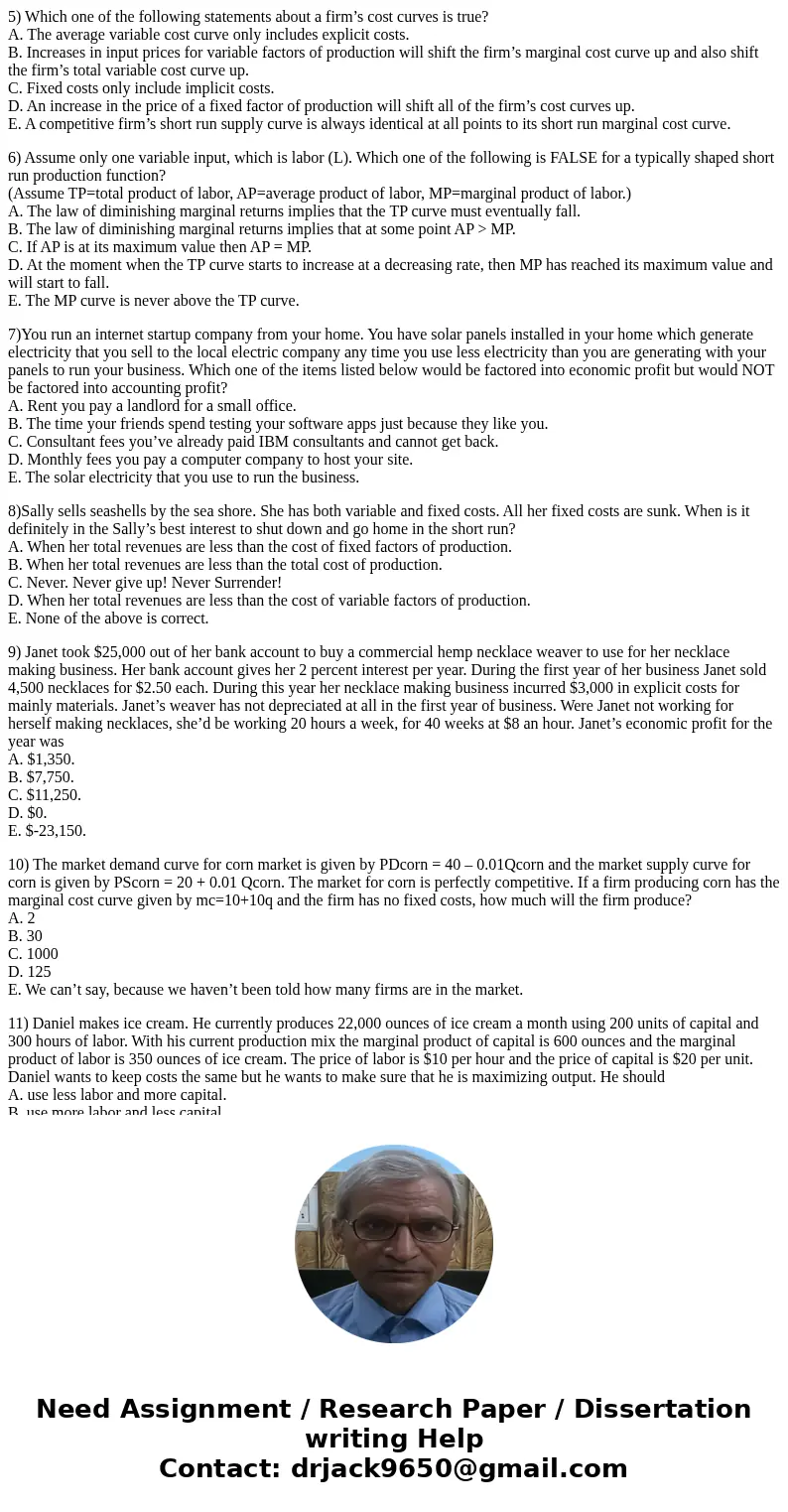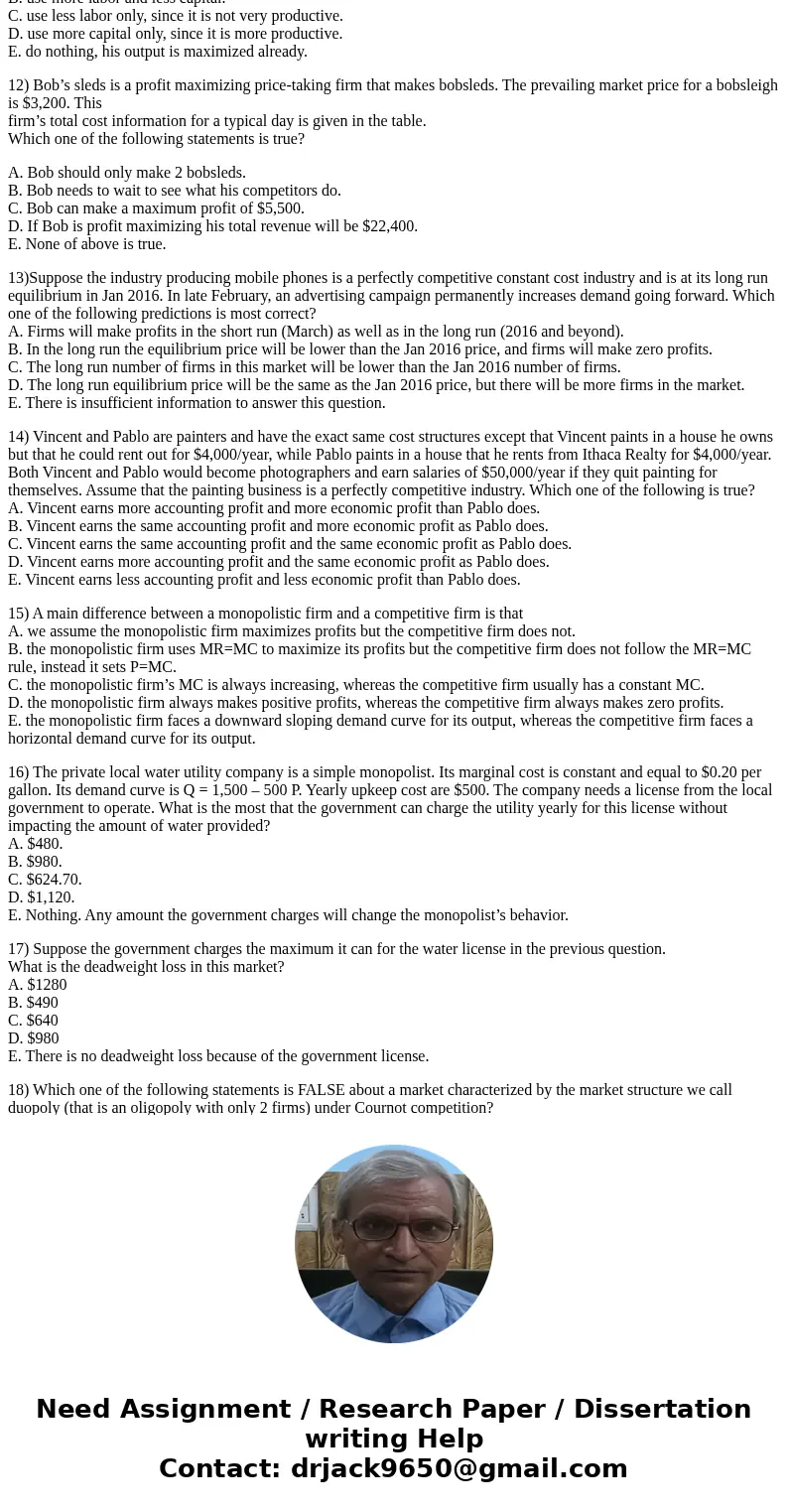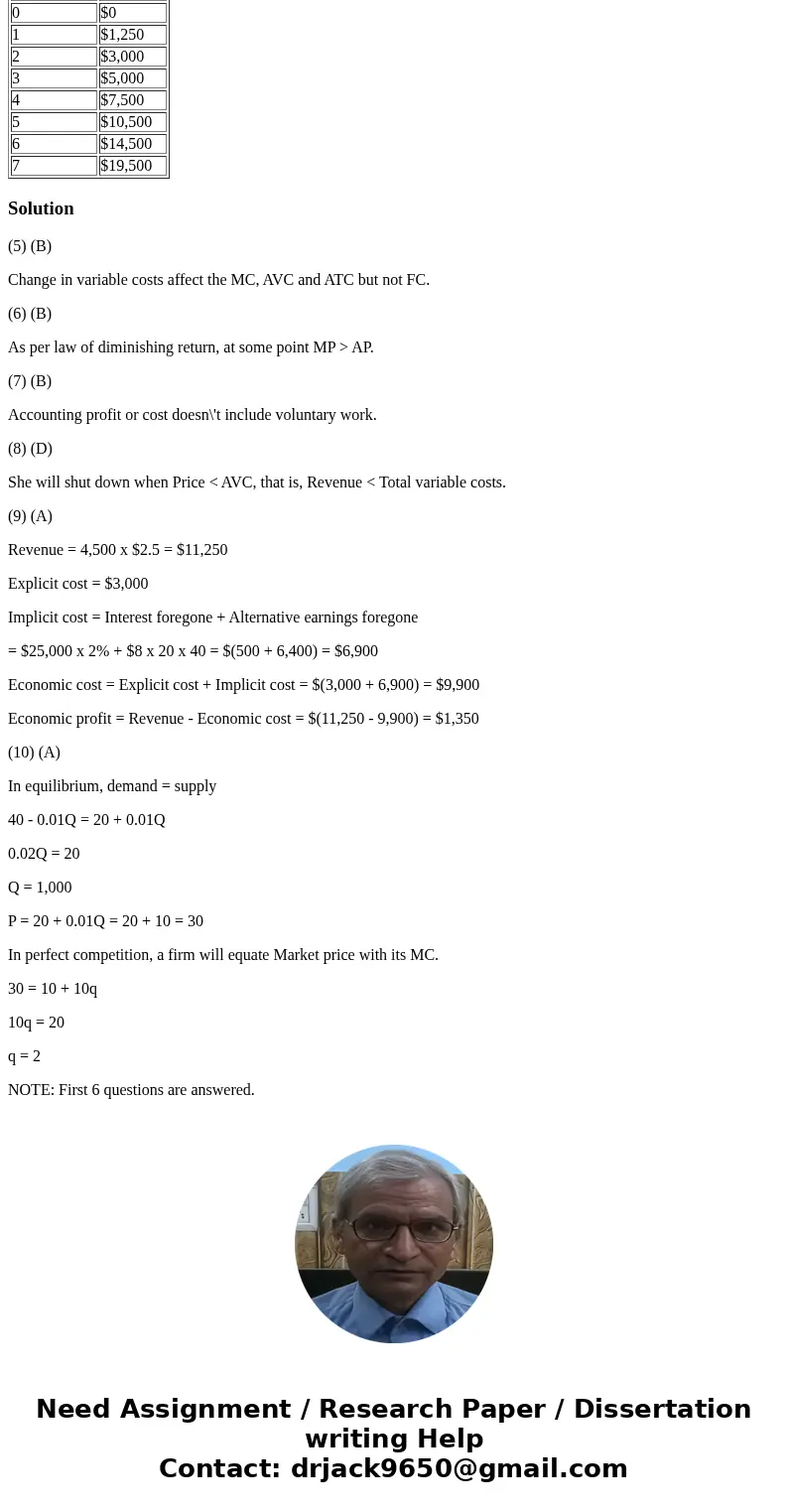5 Which one of the following statements about a firms cost c
5) Which one of the following statements about a firm’s cost curves is true?
A. The average variable cost curve only includes explicit costs.
B. Increases in input prices for variable factors of production will shift the firm’s marginal cost curve up and also shift the firm’s total variable cost curve up.
C. Fixed costs only include implicit costs.
D. An increase in the price of a fixed factor of production will shift all of the firm’s cost curves up.
E. A competitive firm’s short run supply curve is always identical at all points to its short run marginal cost curve.
6) Assume only one variable input, which is labor (L). Which one of the following is FALSE for a typically shaped short run production function?
(Assume TP=total product of labor, AP=average product of labor, MP=marginal product of labor.)
A. The law of diminishing marginal returns implies that the TP curve must eventually fall.
B. The law of diminishing marginal returns implies that at some point AP > MP.
C. If AP is at its maximum value then AP = MP.
D. At the moment when the TP curve starts to increase at a decreasing rate, then MP has reached its maximum value and will start to fall.
E. The MP curve is never above the TP curve.
7)You run an internet startup company from your home. You have solar panels installed in your home which generate electricity that you sell to the local electric company any time you use less electricity than you are generating with your panels to run your business. Which one of the items listed below would be factored into economic profit but would NOT be factored into accounting profit?
A. Rent you pay a landlord for a small office.
B. The time your friends spend testing your software apps just because they like you.
C. Consultant fees you’ve already paid IBM consultants and cannot get back.
D. Monthly fees you pay a computer company to host your site.
E. The solar electricity that you use to run the business.
8)Sally sells seashells by the sea shore. She has both variable and fixed costs. All her fixed costs are sunk. When is it definitely in the Sally’s best interest to shut down and go home in the short run?
A. When her total revenues are less than the cost of fixed factors of production.
B. When her total revenues are less than the total cost of production.
C. Never. Never give up! Never Surrender!
D. When her total revenues are less than the cost of variable factors of production.
E. None of the above is correct.
9) Janet took $25,000 out of her bank account to buy a commercial hemp necklace weaver to use for her necklace making business. Her bank account gives her 2 percent interest per year. During the first year of her business Janet sold 4,500 necklaces for $2.50 each. During this year her necklace making business incurred $3,000 in explicit costs for mainly materials. Janet’s weaver has not depreciated at all in the first year of business. Were Janet not working for herself making necklaces, she’d be working 20 hours a week, for 40 weeks at $8 an hour. Janet’s economic profit for the year was
A. $1,350.
B. $7,750.
C. $11,250.
D. $0.
E. $-23,150.
10) The market demand curve for corn market is given by PDcorn = 40 – 0.01Qcorn and the market supply curve for corn is given by PScorn = 20 + 0.01 Qcorn. The market for corn is perfectly competitive. If a firm producing corn has the marginal cost curve given by mc=10+10q and the firm has no fixed costs, how much will the firm produce?
A. 2
B. 30
C. 1000
D. 125
E. We can’t say, because we haven’t been told how many firms are in the market.
11) Daniel makes ice cream. He currently produces 22,000 ounces of ice cream a month using 200 units of capital and 300 hours of labor. With his current production mix the marginal product of capital is 600 ounces and the marginal product of labor is 350 ounces of ice cream. The price of labor is $10 per hour and the price of capital is $20 per unit. Daniel wants to keep costs the same but he wants to make sure that he is maximizing output. He should
A. use less labor and more capital.
B. use more labor and less capital.
C. use less labor only, since it is not very productive.
D. use more capital only, since it is more productive.
E. do nothing, his output is maximized already.
12) Bob’s sleds is a profit maximizing price-taking firm that makes bobsleds. The prevailing market price for a bobsleigh is $3,200. This
firm’s total cost information for a typical day is given in the table.
Which one of the following statements is true?
A. Bob should only make 2 bobsleds.
B. Bob needs to wait to see what his competitors do.
C. Bob can make a maximum profit of $5,500.
D. If Bob is profit maximizing his total revenue will be $22,400.
E. None of above is true.
13)Suppose the industry producing mobile phones is a perfectly competitive constant cost industry and is at its long run equilibrium in Jan 2016. In late February, an advertising campaign permanently increases demand going forward. Which one of the following predictions is most correct?
A. Firms will make profits in the short run (March) as well as in the long run (2016 and beyond).
B. In the long run the equilibrium price will be lower than the Jan 2016 price, and firms will make zero profits.
C. The long run number of firms in this market will be lower than the Jan 2016 number of firms.
D. The long run equilibrium price will be the same as the Jan 2016 price, but there will be more firms in the market.
E. There is insufficient information to answer this question.
14) Vincent and Pablo are painters and have the exact same cost structures except that Vincent paints in a house he owns but that he could rent out for $4,000/year, while Pablo paints in a house that he rents from Ithaca Realty for $4,000/year. Both Vincent and Pablo would become photographers and earn salaries of $50,000/year if they quit painting for themselves. Assume that the painting business is a perfectly competitive industry. Which one of the following is true?
A. Vincent earns more accounting profit and more economic profit than Pablo does.
B. Vincent earns the same accounting profit and more economic profit as Pablo does.
C. Vincent earns the same accounting profit and the same economic profit as Pablo does.
D. Vincent earns more accounting profit and the same economic profit as Pablo does.
E. Vincent earns less accounting profit and less economic profit than Pablo does.
15) A main difference between a monopolistic firm and a competitive firm is that
A. we assume the monopolistic firm maximizes profits but the competitive firm does not.
B. the monopolistic firm uses MR=MC to maximize its profits but the competitive firm does not follow the MR=MC rule, instead it sets P=MC.
C. the monopolistic firm’s MC is always increasing, whereas the competitive firm usually has a constant MC.
D. the monopolistic firm always makes positive profits, whereas the competitive firm always makes zero profits.
E. the monopolistic firm faces a downward sloping demand curve for its output, whereas the competitive firm faces a horizontal demand curve for its output.
16) The private local water utility company is a simple monopolist. Its marginal cost is constant and equal to $0.20 per gallon. Its demand curve is Q = 1,500 – 500 P. Yearly upkeep cost are $500. The company needs a license from the local government to operate. What is the most that the government can charge the utility yearly for this license without impacting the amount of water provided?
A. $480.
B. $980.
C. $624.70.
D. $1,120.
E. Nothing. Any amount the government charges will change the monopolist’s behavior.
17) Suppose the government charges the maximum it can for the water license in the previous question.
What is the deadweight loss in this market?
A. $1280
B. $490
C. $640
D. $980
E. There is no deadweight loss because of the government license.
18) Which one of the following statements is FALSE about a market characterized by the market structure we call duopoly (that is an oligopoly with only 2 firms) under Cournot competition?
A. The Nash equilibrium exists even if the firms have different cost structures.
B. In the Nash equilibrium the combined profit of the two firms is higher than the combined profits of the two firms if they acted as perfectly competitive firms.
C. The Nash equilibrium market price is less than the price charged by a simple monopolist but more than the competitive price.
D. In the Nash equilibrium the combined profit of the two firms is higher than the combined profits of the two firms if they successfully colluded.
E. In the Nash equilibrium deadweight loss is less than for a simple monopolist in the same market, but still positive.
19) Assume marginal costs are rising at all levels of output. If profits are maximized by a firm, whether monopolistic or perfectly competitive,
A. output should be increased whenever marginal cost is below average total cost.
B. output should be increased whenever marginal revenue is less than marginal cost.
C. output should be increased whenever marginal revenue exceeds marginal cost.
D. the firm should produce at a level where marginal cost is equal to average total cost.
E. We have insufficient information to answer this question.
20) Assume all fixed costs are sunk. The short run supply curve for a perfectly competitive firm is
A. the portion of its short run marginal cost curve that lies above its short run average total cost curve.
B. the portion of its short run marginal cost curve that lies above its average variable cost curve.
C. the portion of the average variable cost curve that lies above its short run marginal cost curve.
D. the portion of its short run marginal cost curve that lies above its average fixed cost curve.
E. the portion of its short run average total cost curve that lies above its short run marginal cost curve.
21) In the morning newspaper, you read an article stating that as a result of the instant monopolization of the local cell phone market, consumers’ surplus fell by $2,000 due to lower equilibrium output, and by $3,000 due to higher prices charged in the market. As a result of the new and higher prices, producer surplus increased by $3,000, but it fell by $2,000 due to the lower equilibrium output under the monopoly. What is the value of deadweight loss, assuming that the cell phone market was originally perfectly competitive and in equilibrium?
A. $3,000.
B. $4,000.
C. $5,000.
D. $6,000.
E. $7,000.
22) Tom and Jerry are the only gourmet cheese cake bakers in town. They are also good friends, so they decide to cooperate and form a cheese cake baking cartel. The inverse market demand for gourmet cheese cake is given by PD = 82 - 5Q. The marginal cost of producing a cheese cake is constant at $2 for both bakers. Based on the information given, and assuming they divide production equally between them, how many cakes does each baker produce at what price if they maximize cartel profit?
A. 4 cheese cakes at $42 per cake.
B. 8 cheese cakes at $42 per cake.
C. 4 cheese cakes at $1 per cake.
D. 8 cheese cakes at $1 per cake
E. 15 cheese cakes at $26 per cake.
| # of bobsleds | Total Cost |
| 0 | $0 |
| 1 | $1,250 |
| 2 | $3,000 |
| 3 | $5,000 |
| 4 | $7,500 |
| 5 | $10,500 |
| 6 | $14,500 |
| 7 | $19,500 |
Solution
(5) (B)
Change in variable costs affect the MC, AVC and ATC but not FC.
(6) (B)
As per law of diminishing return, at some point MP > AP.
(7) (B)
Accounting profit or cost doesn\'t include voluntary work.
(8) (D)
She will shut down when Price < AVC, that is, Revenue < Total variable costs.
(9) (A)
Revenue = 4,500 x $2.5 = $11,250
Explicit cost = $3,000
Implicit cost = Interest foregone + Alternative earnings foregone
= $25,000 x 2% + $8 x 20 x 40 = $(500 + 6,400) = $6,900
Economic cost = Explicit cost + Implicit cost = $(3,000 + 6,900) = $9,900
Economic profit = Revenue - Economic cost = $(11,250 - 9,900) = $1,350
(10) (A)
In equilibrium, demand = supply
40 - 0.01Q = 20 + 0.01Q
0.02Q = 20
Q = 1,000
P = 20 + 0.01Q = 20 + 10 = 30
In perfect competition, a firm will equate Market price with its MC.
30 = 10 + 10q
10q = 20
q = 2
NOTE: First 6 questions are answered.




 Homework Sourse
Homework Sourse